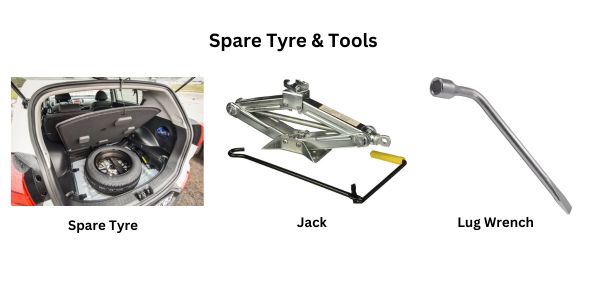Introduction
Ever experienced the stress of a flat tyre on a car in the middle of nowhere? It’s not as difficult as it looks to change a tyre. We’ll lead you through the simple steps in this guide so you can quickly get back on the road. Tyre problems are over, and a new sense of confidence is here. Let us find the answer of title ‘How to Change Car Tyre’ in 14 simple steps.
Table of Contents
14 Steps to Change Car Tyre
Step 1: Safety First
• Slowly and carefully find a flat, safe area away from traffic to park your car.
• Apply the parking brake to prevent moving your car.
Step 2: Use the Parking Lights & Triangle Reflector
● You can alert other drivers by turning on your parking lights. From a distance, they will see the blinking lights, and you can safely change the tyre.
● Place a triangle reflector a few feet from the car for additional warning to alert the passing vehicles.
Step 3: Put Together your Tools and Spare Tyre
● Locate your jack, lug wrench and spare tyre in your car’s trunk.

Step 4: Remove Wheel Covers
● Most of the car tyres are covered with wheel covers. Before removing the flat tyre, these need to be taken off. For instructions on how you can do this, read the owner’s guide. Keep in mind that the settings for wheel covers may vary for various car models.
Step 5: Loosen the Lug Nuts
● Turn the lug nuts anti-clockwise with the lug wrench until they release any resistance. It’s okay if you have to use force. If required, use your foot or your entire body weight. Turn the lug nuts loose by approximately one quarter to a half turn, but keep them in place for the time being. Save that for when you need to remove your wheel or tyre from the car.
Step 6: Place the Jack Under the Car
● Usually, the flat tyre and the area next to the car frame below the frame are the proper locations for the jack. With a cleared area of exposed metal dedicated for the jack, many vehicle frames include moulded plastic on the bottom. Follow the jack position directions in your vehicle owner’s manual to properly raise it to avoid damage to the car.

Step 7: Lift the Car
• Carefully raise the car with the jack until the flat tyre is a few inches above the ground.
• Verify again that the car is properly placed on the jack before continuing.
Step 8: Remove Lug Nuts and Flat Tyre
• Completely remove the lug nuts. You should be able to unscrew them mostly by hand since you’ve already loosened them. Store the lug nuts somewhere secure to prevent loss.
● Grab the treads of the tyre and gradually pull it toward you until it is free of the hub behind it. To avoid it from rolling away, position it on the other side.
Step 9: Place the Spare Tyre On.
• Raise the spare tyre and position it so the lug nut holes are in line.
• Push the spare tyre firmly into the wheel hub.
Step 10: Tight Lug Nuts
• Use your hands to crisscross-tighten the lug nuts as much as you can.
• Tighten them up a bit more with the lug wrench, but don’t totally tighten one at a time. To ensure consistent tightening, rotate between the lug nuts.
Step 11: Lower the Car
● Lower the car back down carefully using the jack.
● Remove the jack from underneath the car.
Step 12: Completely Tighten Lug Nuts
● Completely tighten the lug nuts in a crisscross manner using the lug wrench. Make sure they are tight and secure, but don’t tighten them too much.
Step 13: Replace the Wheel Cover
● Put the wheel cover you removed off the flat tyre back on in the same manner that you did when you first took it off. If it doesn’t fit, store it away with the tyre when you store your equipment.
Step 14: Store Everything
● A jack, a lug wrench, your flat tyre, and possibly a hubcap are all at your disposal. Don’t forget to load them all into your car before you go.
Several Other Professional Tyre Changing Advices
Use of Spare Tyre: It is not advised to complete a long distance on a spare tyre. Some manufacturers provide the spare tyre with specially enhanced edges that let you drive until you arrive to a shop where the primary tyre can be fixed. Spare tyres are not designed for long term usage.
Safety Advise: Never put any part of your body under the vehicle during or after raising the vehicle with the jack.
Tip to Tighten Lug Nut: Use your feet to tighten lug nuts until they are tight enough for you to drive a car safely. The wrench is going to apply more effort as a result, and the nut will screw into place.
Where To Put The Jack: Each wheel on modern vehicles has four jack locations. The jack that comes with the car normally fits exactly in the slots, notches, or grooves that are typically present.
A Tip Regarding Spare Tyre: Unless there is a flat tyre problem, individuals frequently neglect to use the spare tyre. Consider that your car has five tyres instead of four to help you prevent this.
Always Keep a Mat in Car: Maintain a little mat or plastic sheet in the car at all times. This will be useful for positioning your knee on a hard surface when you change the tyre.
Flashlight: Always keep a flashlight in your car. In the dark, a flashlight with working batteries comes in handy.
Conclusion
Finally, knowing how to change a car tyre is an important skill for any motorist. With the step-by-step instructions provided in this blog, you are prepared to competently handle sudden flat tires and maintain the safety and smoothness of your journeys. Always keep in mind that practice makes perfect, so before you find yourself out on the side of the road, take the time to become familiar with the steps in a controlled environment. ‘Happy Driving’

